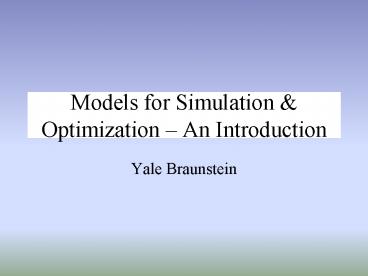Models for Simulation PowerPoint PPT Presentation
Title: Models for Simulation
1
Models for Simulation Optimization An
Introduction
- Yale Braunstein
2
Models are Abstractions
- Capture some aspects of reality
- Tradeoff between realism and tractability
- Can give useful insights
- Cover well-studied areas
- Two basic categories
- Equilibrium (steady-state)
- Optimization (constrained whats best)
3
Specific topics to be covered
- Queuing theory (waiting lines)
- Linear optimization
- Assignment
- Transportation
- Linear programming
- Maybe others
- Scheduling, EOQ, repair/replace, etc.
4
The ABCs of optimization problems
- What can you adjust?
- What do you mean by best?
- What constraints must be obeyed?
5
General comments on optimization problems
- Non-linear not covered
- Unconstrained not interesting
- Therefore, we look at linear, constrained
problems - Assignment
- Transportation
- Linear programming
6
Graphical Approach to Linear Programming
(A standard optimization technique)
7
The SHOE problem
- We want to use standard inputs--canvas, labor,
machine time, and rubber--to make a mix of shoes
for the highly competitive (and profitable!)
sport shoe market. - However, the quantities of each of the inputs is
limited. - We will limit this example to two styles of shoes
(solely because I can only draw in two
dimensions).
8
What can you adjust?
- We want to determine the optimal levels of each
style of shoe to produce. - These are the decision variables of the model.
9
What do you mean by best?
- Our objective in this problem is to maximize
profit. - For this problem, the profit per shoe is fixed.
10
What constraints must be obeyed?
- First, the quantities must be non-negative.
- Second, the quantities used of each of the inputs
can not be greater than the quantities available. - Note that each of these constraints can be
represented by an inequality.
11
Overview of our approach
- Construct axes to represent each of the outputs.
- Graph each of the constraints.
- Optional Evaluate the profit at each of the
corners. - Graph the objective function and seek the highest
profit.
12
Detailed problem statement
- We can make two types of shoes
- basketball shoes at 10 per pair profit
- running shoes at 9 per pair profit
- Resources are limited
- canvas.12,000
- labor hours..21,000
- machine hours.19,500
- rubber. 16,500
13
Resource requirements
Resources Basketball Running
- Canvas 2 1
- Labor hours 4 2
- Machine hours 2 3
- Rubber 2 1
14
Running shoes on vertical axis
Construct axes to represent each of the outputs
Basketball shoes on horizontal axis
15
Graph the first constraint maximum amount of
canvas 12,000
Requirements determine intercepts
16
Graph the second constraint maximum labor time
21,000 hours
Which is more of a constraint?
17
Graph the third constraint maximum machine time
19,500 hours
Why can we ignore the last constraint?
18
The set of values that satisfy all constraints is
known as the feasible region
19
Profit _at_ (0,6500) 58.5K
Optionally, evaluate the profit for each of the
feasible corners.
Profit _at_ (0,0) 0
Profit _at_ (5250,0) 52.5K
20
Graph the objective function and seek the highest
feasible profit.
Profit _at_ (3000,4500) 70.5K
21
In closing two theorems
- The number of binding constraints equals the
number of decision variables in the objective
function. - If a linear problem has an optimal solution,
there will always be one in a corner.

